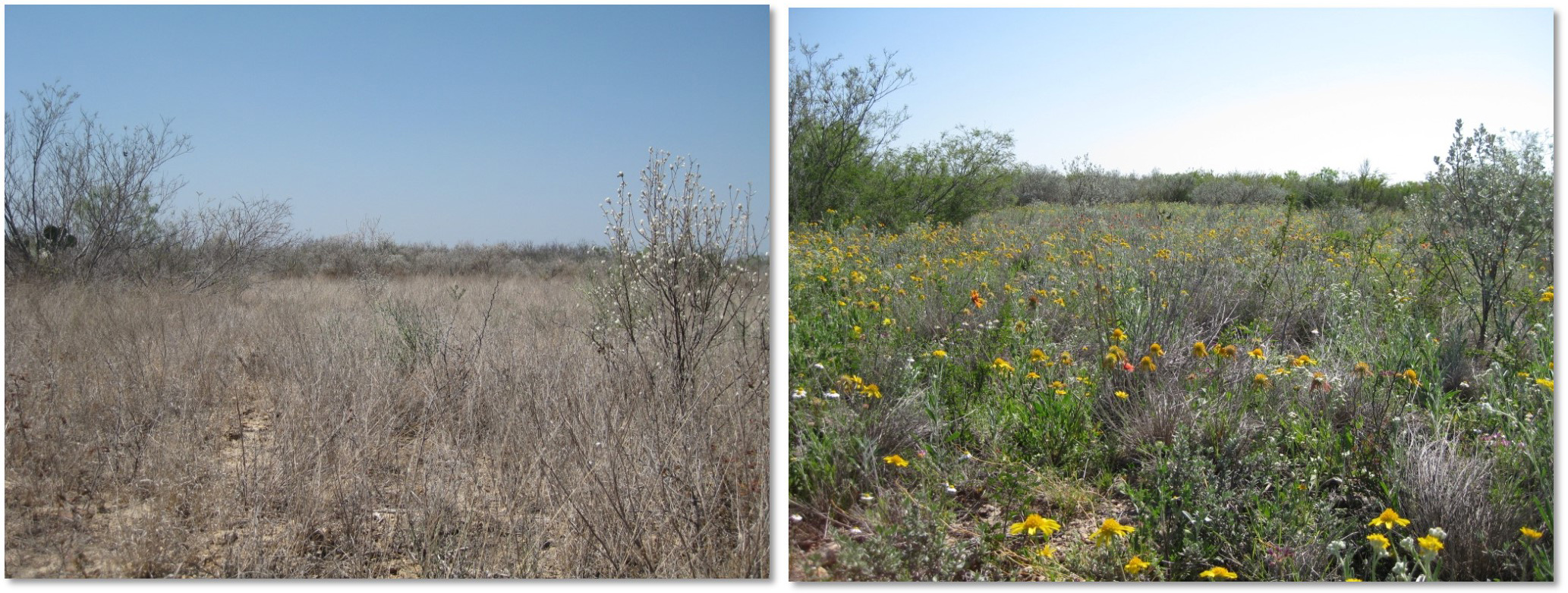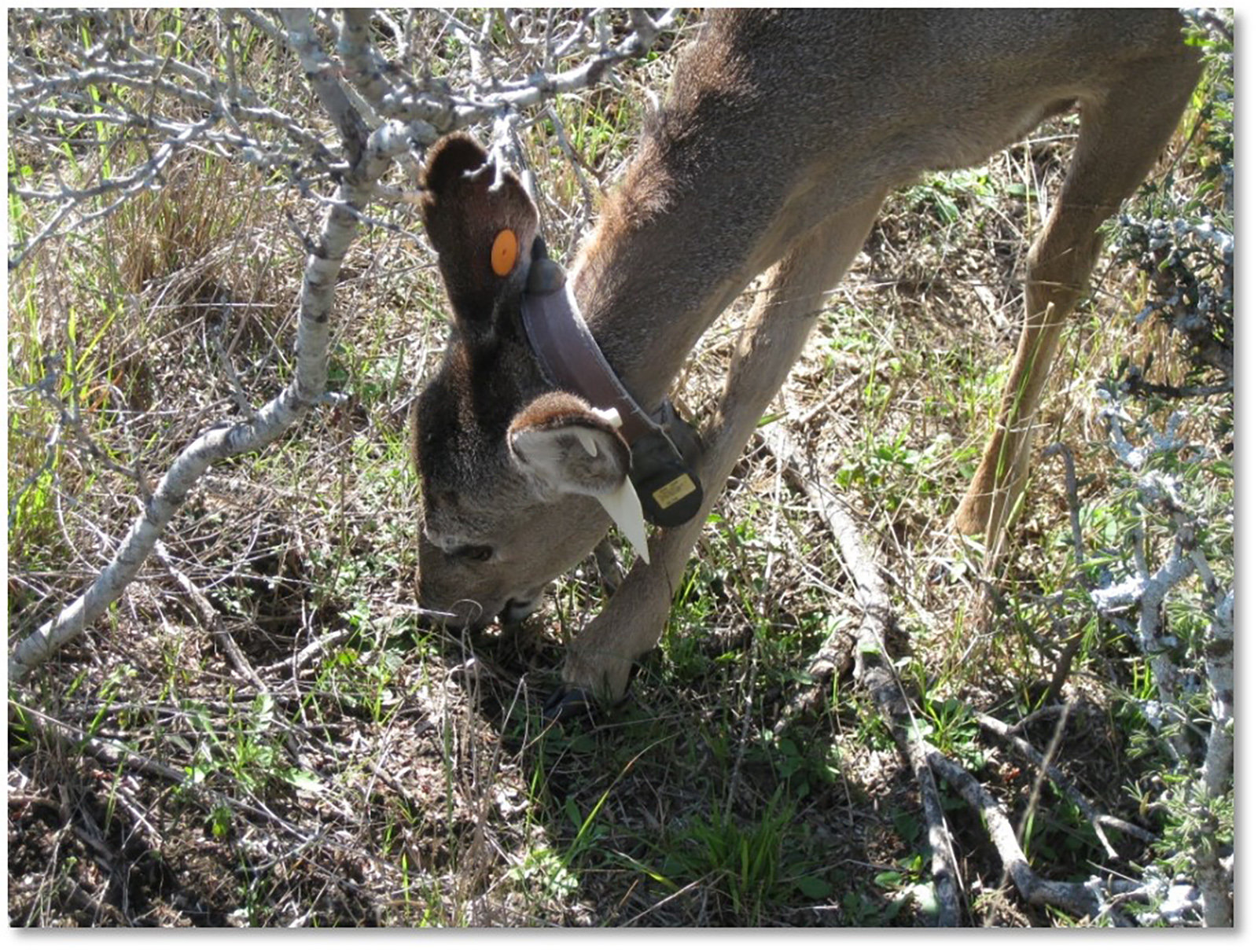By Justin Folks/DWR
Photos by Justin Folks/DWR
In the first article of this series, Food for Thought: A Primer of Deer Diets Part 1, I discussed how deer digest their food and introduced a graduate school research project that aimed to help us understand deer foraging behavior. That article also introduced you to some of the does we watched so intently for the project.
So, what did our ladies tell us? First and foremost, they preferred diverse diets. We recorded bites from 137 different plant species, one species of lichen, and two species of fungi. We were lucky enough that during the two-year course of data collection, each spring, summer, winter, and fall experienced one dry year and one wet year, allowing us to also compare the effects of drought on deer diets. The South Texas brush country is considered “semiarid,” which pretty much means it gets just enough rain to not be a desert, and it’s not enough rain to grow large trees (hence the “brush country”). It is a very boom and bust environment, and I was amazed at how fast the vegetation would respond to rain—it was like the Garden of Eden. However, when it didn’t rain, it was Hell on Earth. There’s really no pattern to it, either, like you might think about the African plains where there’s a wet season and a dry season. See the photos I took from one of the research enclosures from the wet spring we had and the dry spring a year later.

A dry spring on the left, a wet spring on the right.
Contrary to the Optimal Foraging Theory, when rain provided the “Garden of Eden,” deer didn’t narrow their diets and select just the best plants—their diets actually became more diverse. As plant diversity increased, so did diet diversity. When it got dry and vegetation was limited, their diets simplified, regardless of deer density. Basically, when it was wet, food was so abundant from the “plant boom” that deer couldn’t eat it all. When it was dry, however, it was bad for everyone, no matter how many deer were present.
I also learned what they preferred and what forage classes they keyed in on at different times. Our does preferred forbs (non-woody, broad-leaved plants) when they were available. During the wet spring when forbs were abundant, forbs made up over 70 percent of the diet on a dry weight basis! Forbs are typically lower in fiber and higher in digestible protein than other forage classes. Shrub leaves were a staple of the diet, but were eaten more during dry periods.
Over the whole study, intake of digestible protein was always above maintenance levels and usually adequate for reproduction (except the really dry periods). Grass was always 2 percent or less of the total diet at any point in time, even in the high density enclosures, reinforcing the fact that deer are not grazers (the only time they ate grass was when it was young and tender).
A real eye-opener for me was how focused the deer became on mast (lotebush berries, mesquite beans, guajillo pods, prickly pear fruits, and more) when it was available. It was like someone flipped a switch. When mast ripened in the summer, it became about half of their diet, regardless of drought conditions or deer density. I didn’t fully appreciate what was going on until after we ran all the nutritional analyses and I pondered things some more.
The soft mast was high in sugar (a simple carbohydrate and easily absorbed source of energy), and the hard mast was high in fats and oils (which yield the most calories per gram). Since mast is only available for a limited time and energy is the most limiting nutrient on the landscape, the deer took advantage of that resource while they could. Many animals (including deer and humans) have evolved to survive periods of limited energy availability. Our systems are well-designed to take in energy when it’s available (summer/fall) and store it as fat to burn when food is limited (winter).

Some forbs over-winter as rosettes and were still an important part of the diet for our deer, including “Lily,” seen here. Previous diet studies looking at rumen contents of dead deer underrepresent forbs because they digest more quickly and are more difficult to identify than more fibrous foods like tree and shrub leaves. Forbs are also not as prevalent in the fall when hunting seasons are in.
When you think about it, it’s how these low-carb diets work—you trick your body into thinking it’s winter (fat-burning mode instead of fat-storing mode). Deer can’t run to the store and get high-calorie foods whenever they want, so they exploit the mast while they can. Because I have access to junk food, my body hasn’t seen a “winter” for a while now. Note that even though energy is a critical nutrient with limited availability, deer still mixed in plenty of other vegetation along with the mast to acquire other important nutrients and avoid rumen acidosis or bloat.
Side note—remember I mentioned we had enclosures with pelleted feed as well? We all had to fill those feeders on a weekly basis, and I can tell you that when we had rain, the deer weren’t hitting the feeders as hard, suggesting that they preferred the natural forage over the pelleted feed.
Bringing it Home
What does a South Texas deer diet study have to do with Virginia deer? Most everything, really. The digestive system and nutritional requirements of a Texas deer are no different from a Virginia deer or a deer in Canada. They experience different environmental stressors, but the basic animal is the same.
In summary, deer prefer diverse diets, especially rich in forbs. They really like the native stuff, so this goes way beyond clover, chicory, and other non-native food plot species. I consistently find bites taken from beggar’s lice, goldenrods, ragweed, asters, coreopsis, pokeweed, wood sorrel, sida, groundcherry, woodland sunflower, and much, much more.
The beautiful thing about all these native forbs is that they produce food and cover not just for deer, but also for other wildlife like turkeys, rabbits, quail, grouse, and scores of nongame species, and you don’t have to fertilize them! A meadow or woodland full of native forbs gives a fawn ample places to hide while momma doe fills up on nutritious forage. Rainfall (or the lack thereof) is what drives forb abundance in South Texas. The semiarid climate maintains a plant community that would be considered early succession here. We get enough rain to produce forbs most years—it takes disturbance (prescribed burning, discing, timber management, etc.) to maintain forb-rich plant communities in Virginia.
When managing your property for deer, always keep in mind that deer need high quality deer habitat 365 days a year—it’s not just about what’s attractive to deer during hunting season. Do all you can to promote diverse native forb communities throughout the growing season as well as soft mast (blueberries, blackberries, persimmons, apples, grapevines, wild cherry trees, etc.). Start paying attention to the plants that have bites taken out of them in the spring and summer, identify them, and encourage the native species over the non-native ones.
When these plants die back in the fall and aren’t high-quality foods anymore, they will still provide cover. When it comes to hunting, mast will trump nearly every food plot, so set up on those persimmons and apple trees in the early season and then focus on acorns when they start falling to increase your chances of success.
One key point worth noting is that while higher deer densities didn’t seem to significantly impact deer diets and whatnot in our study in South Texas, overabundant deer can (and do) have a negative impact in milder, wetter climates (like Virginia). One of the conclusions from the entire study is that density dependence doesn’t operate the same across all environments. In the case of our study, rainfall (or the lack thereof) had the biggest influence on diets, vegetation, and more.
The concept of density dependence in deer was first demonstrated in the George Reserve deer herd in Michigan and seems to apply throughout most of the whitetail’s range. Deer densities must be well-balanced with their habitats through doe harvest, and we must continue to manage this balance to ensure healthy herds and habitats in the future. Virginia’s plant communities aren’t boom and bust like South Texas, so sustained high deer densities can certainly negatively impact our local ecosystems and the deer themselves.
My key takeaways from my experience with these ladies come down to these three things: diversity, forbs, and mast. Even when the best food was abundant and readily available, they still expanded their diet to include a lot of other things. Forbs are generally the preferred forage, but when mast is available, the switch gets flipped.
Deer don’t need feed—they need forage; and mimicking the Brush Country vegetation in Virginia through disturbance can provide high quality forage AND cover on the same footprint. Give them a native buffet and they’ll be just fine without any sort of supplements (and without the increased risk of disease transmission). Food for thought.
Until next time… Be safe, be ethical, and pass it on.
Justin Folks is DWR’s deer project leader.


